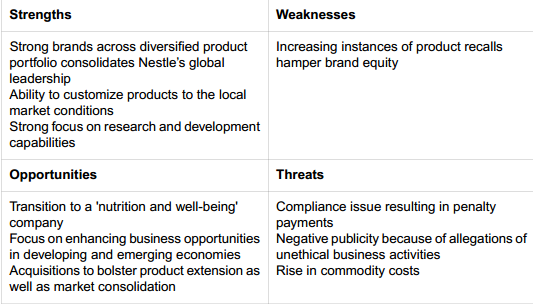
- •International Human resource management course
- •Nestle: Background, markets, strategy.
- •1.1. History
- •1.2 Operations, products, services5
- •1.3. Product markets
- •1.4. Geographic markets
- •1.5. Strategy and organizational structure
- •1.6. Corporate culture
- •Human resource Management at Nestle
- •2.1. Ihrm strategy and corporate culture
- •Job analysis and planning
- •Recruitment
- •Expatriate issues
- •Training and development
- •Career management
- •Performance Appraisal
- •List of references
- •Appendix 1.
1.5. Strategy and organizational structure
Nestlé’s goal is to become the world leader in Nutrition, Health and Wellness products. The company is aiming to gain high level of trust by all its stakeholders, and to become paragon in terms of financial results. Actually, declared direction to health and wellness is demanded by market. For the next several years increase in health awareness, growing government spending on reforms connected with healthcare in emerging countries as well as growing concern about life-style related disease are is expected to be main reasons for changes in food and beverage industry. So that, Nestlé’s strategy seems to be an appropriate answer for new tendencies. The company’s slogan “Good food, good life” also highlights this new trend of development.
The company tries to combine long-term and short-term approaches, stressing the importance both of inspiration and delivering results. The company is trying to gain consensus with all stakeholders and “create shared value” for all. To create opportunities in the future, the company invests heavily in capacity, technologies, capabilities, people, brands and R&D. Indeed, Nestle’s R&D is regarded as one of the most powerful advantages of the company.
Actually, such vision of situation and development of health and wellness-oriented strategy are assessed by analysts as a good reaction. Let’s analyze data provided by Datamonitor.

Picture 1. SWOT-analysis for Nestle. 201110
Here we can see already mentioned strengths of the company: strong brands, adaptation to local environment, R&D potential. The weaknesses and threats are more interesting. Indeed, Nestle got much cases of product recalls (and this can indicate some operational problems at production): possible small pieces of glass in Nescafe, plastic inside meatballs etc. This certainly leads to decrease of customer’s trust. Cases of non-compliance – accusation in use of child labour at supplier’s firms, and attack of Greenpeace on use of palm oil in Kit Kat11 also are not favorable to company’s reputation. That’s why we can see recommendation to “translate into nutrition and well-being company”, what Nestle, actually, is trying to do. As the industry of operations is old, method of acquisition can be beneficial way of growth (taking into consideration wide experience of Nestle in different countries). As emerging markets are showing growth it is quite reasonable to catch up with these changes.
All in all, the company consider its range of products, R&D activities, geographic presence, people and culture as main competitive advantages and is going to build on them further strategy. The company wants to explore such trends as growing health and wellness awareness, development of emerging markets, development of still increasing “out-of-home” segments and “premiumisation” (introduce and develop products for high-quality and so on high-margin segments, what has already been successfully done with Nespresso and Perrier). To ensure proper implementation of the strategy, company stand out several key factors: innovations, operational efficiency, consumer communications and accessibility of products.12
As it was already mentioned several times, the company pays high attention to innovations. Nestle wants to keep entrepreneurial spirit in company, that’s why its structure is decentralized. It is also connected with mode of internationalization. As the company grows mostly through M&As, buys established companies and adapt to local conditions, it needs to remain flexible. So that, the company tries to give as much freedom to its subsidiaries as possible.
The company uses matrix structure. Strategy decisions defining further development are made at the headquarter level, while all operational decisions are left up to subordinate organizations. The matrix is composed by product managers and functional managers.13 So that the problem arises: every project has 2 leaders. In such big company as Nestle it could lead to great mess. That’s why the company develops special programs for its managers to eliminate such conflicts and is trying to establish clear policies to avoid misunderstanding. Matrix structure is also used in geographical subsidiaries. The official structure of Nestle as it is given in its reports you can see in app. 1. All 13 divisions (functional, geographical, product group) are reporting directly to CEO and have got all their freedom to operate. As we see, Human Resources is one of these “basic” divisions, defining centralized strategy (but not concrete operations) for all company.
